Table of content
Forex commodity currencies are the currencies issued by countries, which have large amounts of commodity reserves. When it comes to those nations, they are one of the largest producers of one or several types of commodities and therefore, the price of those tend to have a major impact on their economy.
Commodity currencies list in Forex trading includes the Australian dollar (AUD), the Canadian dollar (CAD), the New Zealand dollar (NZD), Norwegian Krone (NOK), and Russian ruble (RUB). Australia has a significant amount of gold and silver reserves and its local mining companies produce hundreds of tonnes of precious metals. Therefore, the price of those commodities rises, the Australian mining companies earn higher profits, while the Australian government also benefits from the increased tax revenues. This is exactly why the Australian dollar is usually closely tied to the gold price.
The exchange rates of the Canadian dollar and Russian ruble are closely tied to the oil commodity market. Those two respective countries are one of the largest exporters of oil in the world. As a result, the changes in the price of this commodity can have a major impact on the exchange rates of those two currencies.
New Zealand is famous for its massive production of dairy products, a significant portion of which it exports abroad. This is why the New Zealand dollar has a positive correlation with commodity prices in this sector.
Finally, it is worth mentioning that despite the fact that those currencies are highly correlated with some commodity prices, it does not mean that it will always be the case. Some factors, like changing interest rates, global economic growth trends, geopolitical developments, and other events can disrupt the normal trading patterns in the Forex market. Therefore, in some cases, the paths of commodity prices and commodity currency can diverge for some time and it might take some months before this relationship can be restored.
Why some People are Interested in Investing in Commodity Currencies
Before moving on to a more detailed explanation of how to trade the commodity and currency pair, there are questions we must address: Why so many people are interested in trading with or investing in commodity currencies? Why not just stick to the world’s reserve currencies like the US dollar, Euro, Japanese yen, and British pound?
Well, there essentially 3 main reasons why this might be the case. Firstly, it goes without saying that the diversification of a portfolio has always been one of the most important principles both in investing and trading. Therefore, by investing in those currencies, traders and investors are able to achieve greater diversification and potentially reduce their risk exposure in the process. This also gives them an opportunity to earn higher returns in case of an appreciation of one of the biggest commodity currencies.
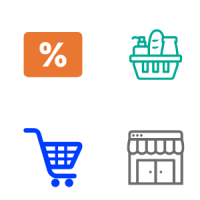
Obviously, this is not the only reason why investors and traders might want to get involved with those currencies. One of the apparent reasons for their appeal is the fact that very often commodity currencies give market participants opportunities to earn higher potential yields.
This became especially important in the aftermath of the 2008 financial crisis. As the US Federal Reserve, along with the majority of major central banks reduced its interest rates to near-zero levels, investors were desperately looking for currencies that could offer some reasonable returns for their investments. During this period the Australian dollar and New Zealand dollar became two very attractive alternatives since their respective central banks maintained considerably higher interest rates than some of their peers.
Even after the outbreak of the COVID-19 pandemic, when the Reserve Bank of Australia reduced rates to 0.25%, the Russian central bank still maintains its rate at 4.5%, which can be attractive for some carry traders.
The third and possibly the greatest reason why people invest in commodity currencies is the fact that it can be a more convenient way to invest in the commodity sector. It is true that if traders want to invest in order to benefit from the rise of gold prices, then they essentially have 4 options:
- Buy physical gold, whether it will be in the form of bullion or coins
- Invest in gold Exchange Traded Funds (ETFs)
- Invest in gold mining companies
- Buy the Government bonds or Certificates of Deposit, denominated in AUD
So as we can see if an individual wants to position his or her portfolio in a way to have exposure to the prices of precious metals, there are plenty of options. However, each of those methods might have some significant downsides.
Firstly, there are storage costs involved with purchasing physical gold. It goes without saying that keeping gold coins and bars at home is not really the safest option. After all, this can make the house a very appealing target for robbers. As a result in the event of robbery investors can lose a significant portion of his or her net worth in a single day. Hence the necessity to store it in a bank vault, which does incur some storage costs. The ETFs do not offer a free option either, they do have some management fees associated with them.
Here it is also worth noting that physical gold and ETFs do not pay any dividends or interest. So they are not very attractive options for income investors.
One obvious downside with purchasing gold mining stocks is that here the principal amount of investment is not secure. Therefore it is very much subject to daily market fluctuations. The second drawback of those types of investments is the fact that investors have to pay a commission to buy a stock and many brokerage companies also charge a monthly fee for the account.
Faced with those problems some investors decided to get involved with this sector by investing in commodity currencies. Here market participants can earn some interest from Australian government bonds, Certificates of Deposit, and other fixed-income instruments. At the same time, Forex traders can trade commodity currencies and earn stable revenue by using carry trading strategies. This means that a trader can borrow low-yielding currency in order to purchase high-yielding currency and then receive a daily income due to interest rate differentials.
At the same time, those traders and investors can also benefit from rising prices of commodities, because those currencies tend to have a high degree of correlation with those. So for example, if an individual invests in the assets denominated in Canadian dollars, he or she can certainly benefit from rising oil prices, since this tends to push CAD higher as well.
So as we can see in many cases traders and investors can trade commodity currencies as a proxy for the prices of oil, gold, dairy, and other commodities.
Commodity Correlation with Currencies
Seasoned commodity traders are well aware of the fact that the currency commodity relationships can be very strong and persist for years. In order to illustrate this reality, let us take a look at this daily chart, showing the price action for Crude oil for the last 3 years.
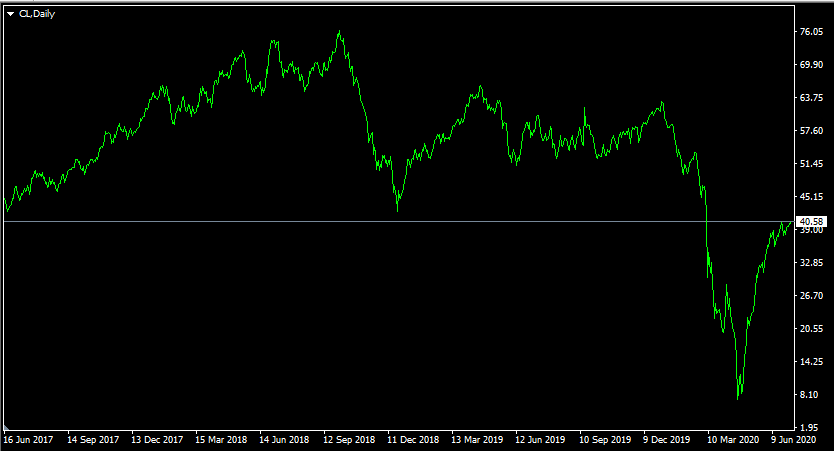
As we can see from the image above, by June 2017, the oil price stood close to $45 level. During the subsequent months, the price of this commodity has risen considerably, eventually reaching a high watermark of $76 in October 2018. This is the point when the downturn began. The initial decline took the prices right back to $45 by December 2018, wiping out more than 15 months’ worth of gains in a matter of 2 months.
However, this setback has proven to be temporary. By April 2019, the Crude oil had risen to $66 mark and mostly stayed within $60 to $66 range until January 2020. The outbreak of the COVID-19 pandemic, as well as subsequent lockdowns and travel restrictions, imposed by the governments around the globe, led to a notable decrease in the demand for fuel. As a result of those developments, the oil price collapsed, dropped below $5 mark, and even briefly ventured into the negative territory. This did not last long, however, as the price steadily recovered and returned to $41 by the beginning of July 2020.
So how did those price developments affect the exchange rates of commodity currencies? In order to answer this question, let us take a look at this daily USD/CAD chart:
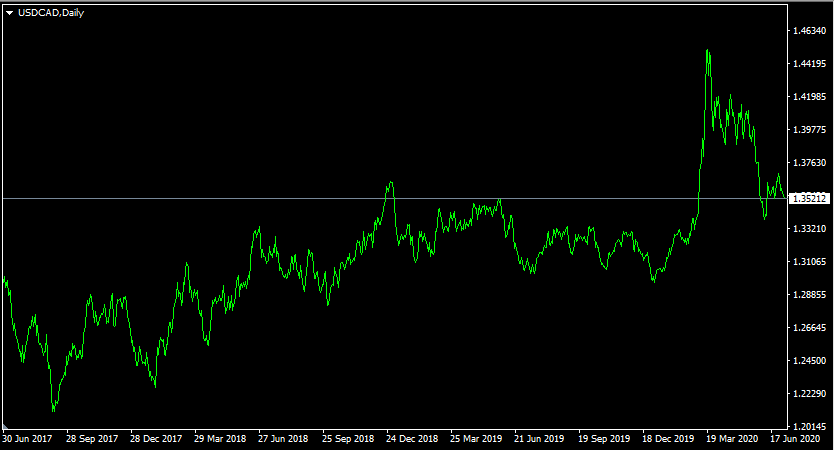
As we can see from this diagram, 3 years ago the pair was trading close to $1.30 level. Benefiting from the strength of the oil market, the Canadian dollar has made some significant gains, with USD/CAD dropping down to $1.21 level by September 2017. Despite those developments, during the subsequent months of trading, the US dollar started to display more strength, benefiting from the repeated rate hikes from the US Federal Reserve, taking interest rates from 0.25% to 2.50%. As a result, despite the constant fluctuation, the USD/CAD pair rose to $1.36 level by January 2019.
However, as soon as the US central bank ended its rate hike cycle, the strength of USD started to fade. As a result, after months of ranged trading, USD/CAD fell to near $1.29 level by January 2020. The pair reacted strongly to the collapse in oil prices. Consequently, USD/CAD has risen sharply, reaching $1.45 level during the middle of March 2020. Those extreme levels lasted for a couple of months. However, as the Crude oil regained its strength and returned to $40, the pair responded with a steady decline, with the exchange rate eventually retreating back to $1.35 by early July 2020.
Extent of Commodity Currency Correlation in Emerging Markets
When discussing the commodity fx correlation it is worth noting that this sort of relationship extends to some emerging market currencies as well. To illustrate this, let us take a look at this daily USD/RUB chart:
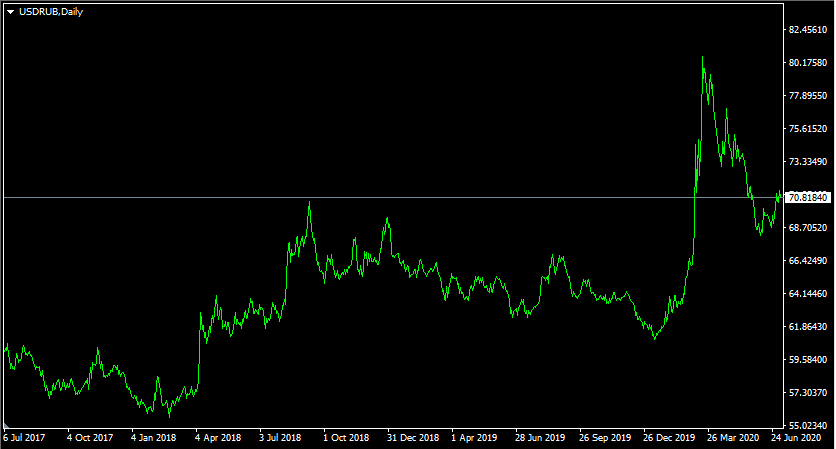
This image shows that back in July 2017, the pair was trading near 60 level. The rise in oil prices did support the ruble exchange rate, as a result of which the USD/RUB pair dropped down to 55 mark in late February 2018. However, just like in the case of the Canadian dollar, the repeated interest rate hikes by the US Federal Reserve has strengthened the USD. As a result, the USD/RUB exchange rate has risen to above 70 level by September 2018.
However, this show of strength was rather short-lived. Here it is worth noting that by December 2018, the price of this commodity has begun another uptrend. This strengthened ruble considerably, with the USD/RUB rate eventually dropping to $61 level by January 2020.
Just like in the case of USD/CAD, the collapse in the oil prices led to a massive surge for the USD/RUB, which eventually surpassed 80 level in March 2020. However, as soon as the oil price began to recover, the pair also began to moderate its exchange rate, dropping down to 68 level in June 2020. During early July 2020, the USD/RUB traders at 71. This rise in the exchange rate during this one month was more a result of the interest rate cut by the Bank of Russia, rather than any significant developments in the oil markets.
How Traders Can Make Use of Commodity Market Correlation?
At this stage, the obvious question remains: how traders can utilize commodity trading correlation for their advantage? Well, after analyzing the above example, we can come up with several principles for trading with commodity prices:
- Firstly, it seems very obvious that everything else being equal, commodity currencies tend to rise and fall with commodity prices. Therefore, regular monitoring of the latest developments of those markets can give us valuable insights into the potential developments of such pairs as USD/CAD, AUD/USD, USD/NOK, NZD/USD, USD/RUB, as well as other pairs related to commodity currencies.
- Secondly, traders wishing to trade in the commodity and currency must keep in mind that the correlation between those two asset classes is far from perfect. Some factors, especially the central bank interest rates can significantly disturb the normal trading patterns of a given currency pair. We have seen for example, that despite the rise in commodity prices USD/CAD rose, because of the rate hikes of the US Federal Reserve. Also, the price of oil has held steady in June 2020, but the Russian ruble exchange rate fell, because of the rate cut coming out of the Bank of Russia.
- Also, it is worth noting that in most cases the effects of interest rates are temporary. After the initial reaction and some weeks of trading, this tends to fade and normal trading patterns resume. However, there are some exceptions to this as well, something we will address in more detail below.
- Finally, it is also worth noting that the correlation between actual commodity prices and commodity currencies is more visible on the longer-term daily and weekly charts. In the shorter-term timeframes, it might not be so apparent.
Divergence Between Commodities and Commodity Currencies
Before moving on to the concluding remarks, it is important to mention that there were individual commodity currencies diverged from commodity prices for a considerable length of time. Those developments are usually a result of a major shift in the monetary policy, rather than one individual rate cut.
One obvious example of such a scenario is the case of the relationship between the Australian dollar and gold prices. For many years those two assets have been closely tied together. In fact, the degree of the positive correlation was so high that some traders and investors were using AUD as a convenient proxy for playing in the gold market.
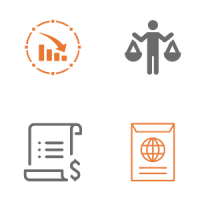
This relationship was temporarily broken down from November 2018 until March 2020. One the one hand, the price of gold has risen steadily during this period from $1180 to $1680. Despite the fact that this precious metal was making such dramatic gains, the Australian dollar fell steadily, with AUD/USD dropping from $0.71 all the way down to $0.57.
This development might be very surprising. After all, as one of the largest producers of precious metals in the world, the Australian economy was well-positioned to benefit from the rising gold prices.
One possible explanation for this tendency is the fact that it was during this exact period when the Reserve Bank of Australia has started cutting its interest rates. At the beginning of 2019, the rates stood at 1.50%. Well, this was not ideal, but it was at least better than some other central banks, with some of them even going as far as to introduce negative interest rates, like the Swiss National Bank and Bank of Japan did some years ago.
However, the Reserve Bank of Australia did gradually reduce the interest rates, eventually dropping them all the way down to 0.25% by March 2020. As a result, the Australia dollar became much less attractive for investors and traders. The reasoning behind this was the fact that now savers and investors earn much lower returns on the Australian government bonds, Certificates of Deposit (CDs), savings accounts, and other fixed-income instruments. At the same time, AUD became unappealing to carry traders, since they could earn very little return from opening a long position for the currency.
So this explains the reason why the Australian dollar fell consistently during this period. However, once the Reserve Bank of Australia has reached 0.25%, there is very little policymakers can do. Obviously, they can imitate the European Central Bank and cut rates to 0%. However, this might have very little impact on the Economy. Some of them might consider moving interest rates into negative territory. However, as we can see from the experience of the Swiss National Bank and Bank of Japan, those steps can come with a lot of unintended consequences.
Therefore, once the rate cut cycle was over, the old relationship between the AUD and the gold price was restored. As the XAU/USD moved up to $1,778 level, the AUD/USD has risen from $0.57 to well above $0.69. As long as the Reserve Bank of Australia does not cut rates further, this high degree of correlation is highly likely to persist. Obviously, if at some point, the RBA decides to lift rates and start to normalize policy, this can also have a positive impact on the exchange rate of the Australian dollar.
Trading Commodity Currencies – Key Takeaways
- Currencies which are issued by countries with one of several types of large commodity reserve are usually known as ‘commodity currencies’. Instead of a general correlation between the commodity currencies index and actual prices of those commodities, each currency is tied to one or several specific commodities. As a result, there is a high degree of a positive correlation between those two types of assets. This means that they tend to move in the same direction.
- The Canadian dollar (CAD), the Norwegian krone (NOK), and Russian ruble (RUB) are all commodity currencies and closely tied to the oil price. The reason for this is the fact that those 3 countries are one of the largest oil producers and exporters in the world. The Australian dollar (AUD) is usually highly correlated with the Gold price and the New Zealand dollar (NZD) is closely tied with the dairy prices. The relationship between commodity prices and commodity currencies can last for several years or even decades.
- Despite the validity of those arguments, this does not necessarily mean that this tendency will persist indefinitely. Factors such as interest rate changes can significantly disturb the normal trading patterns of currency exchange rates. At some point, the paths between those two assets can diverge and it might take months or even years for this old relationship to be restored. Therefore, when trading commodity currencies it is vital to keep track of the latest developments not just in commodity markets, but to the latest changes on the monetary policy as well.



